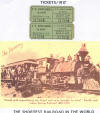
FLOVILLA &.INDIAN SPRINGS RAILWAY
(Less than 3 miles)
In 1888 a stock
company capitalized at $10,000 was organized by W. F. Smith for the purpose of building
an interurban railway line between Flovilla and Indian Springs. This line was called
the Flovilla &. Indian Springs Railroad with John R. L. Smith, president; George
B. Elder, vice-president and treasurer; W. F. Smith, secretary; and Robert V. Smith,
general manager.
Because of the need to transport passengers
from FIovilla, which was on the main line of the E. T. V. &. Ga. R. R., to Indian
Springs, this railway came into being and had the distinction of being the shortest
Incorporated railroad In the world. It was built in 1888. At first horses were used as power, but they
were later replaced by steam. The steam train, more familiarly known as the "Dummy,"
was one of the most colorful trains in the entire state's history. At that time travel by train was extremely
popular with excursions and special rates. Excursionists would disembark from the
main line of the E. T. V. &. G. R. R. at Flovilla and clamber aboard the Dummy
for the trip to Indian Springs. The Dummy made the trip between Flovilla
and Indian Springs several times a day, stopping at the Holiness Campground during
that meeting In August of each year. The tiny train would be loaded and at times
absolutely overflowing, with passengers standing on the platform. A. O. Lynch of FIovilla, later a well-known
surgeon in Atlanta, was the first. engineer of the Dummy. Replacing him later was
J. P. Smith of Brunswick, formerly an engineer with the Southern Railway. Messrs.
Bob Whitehead, Mann Fuller, and Bunt Maddox served as firemen and Paul Bailey as
brakeman. The last year the Dummy operated, Butler Smith served as conductor. The I. S. &. F. R. R. continued in operation
for 30 years after Its construction, realizing a large traffic each year from visitors
to the Indian Springs Holiness Campground. During its years of activity there was
not a single life lost. War conditions, the increased cost of operation, and cheap
competition forced the railroad to be operated at a loss. Through a financial deal with the Southern
Land &. Loan Company, a Mr. Hale became president of the road. The project was
not a paying proposition and the minority stockholders asked for a receiver. Judge
Gober granted their plea. In 1917 the Dummy gave way to the automobile.
It was discontinued in 1918 and its two engines and six passenger cars were sold
as junk. The two engines were bought by the United States Government, which used
one of them to carry troops and munitions to-the front when the army was fighting
in France during World War I. Other metal from the Dummy line was used for scrap. During its short, interesting, and colorful
career, the Dummy provided fun and convenience for numerous passengers. A way of
life disappeared with it, but many fond memories of the tiny train are held by the
people who still remember It.' " In the rear of the J. T. Edward store
building in Flovilla there is still standing today the sheds which housed the passengers
waiting to ride the Dummy.
Compilation Copyright 1997 - Present by The GAGenWeb Project Team
